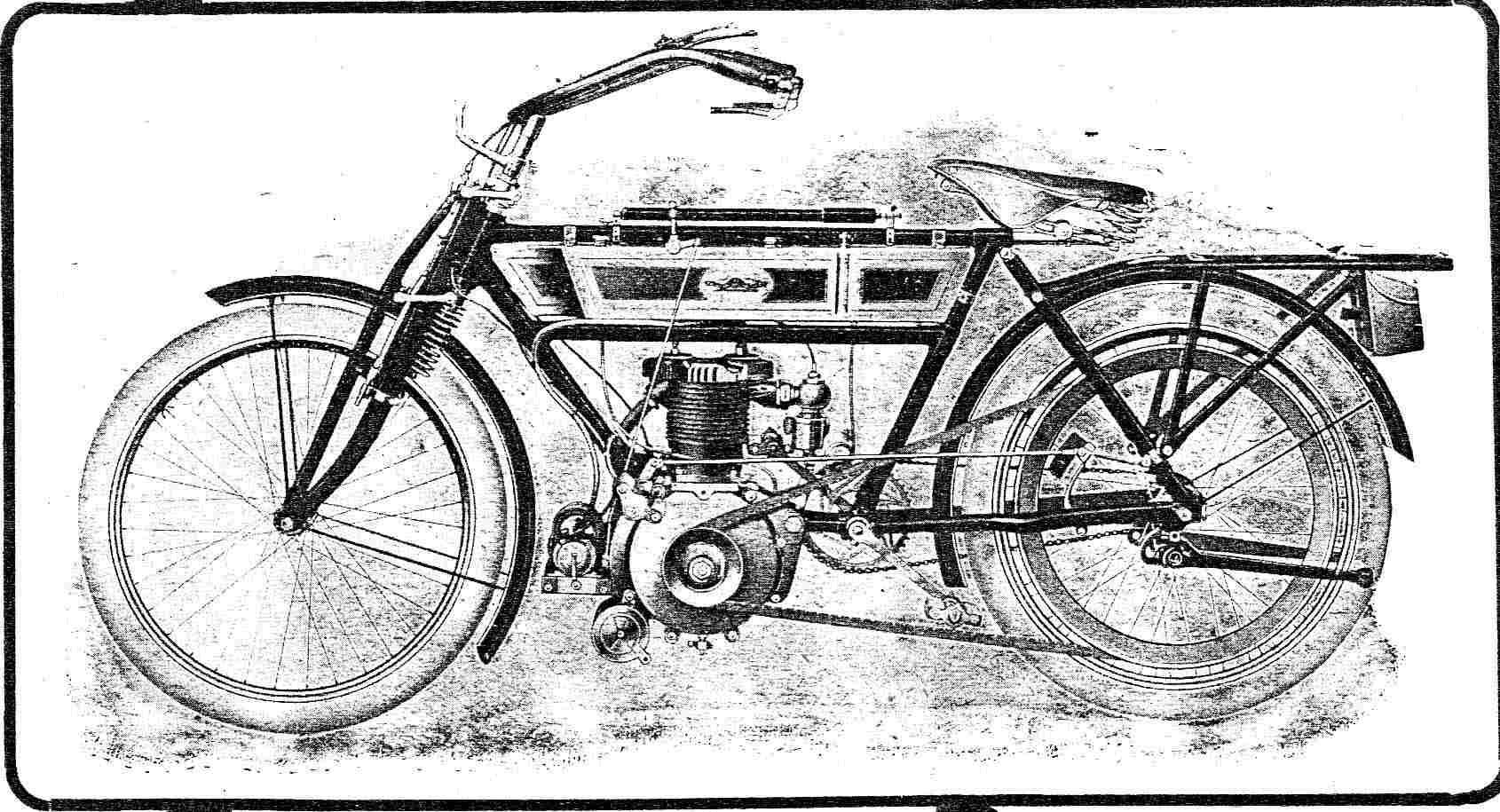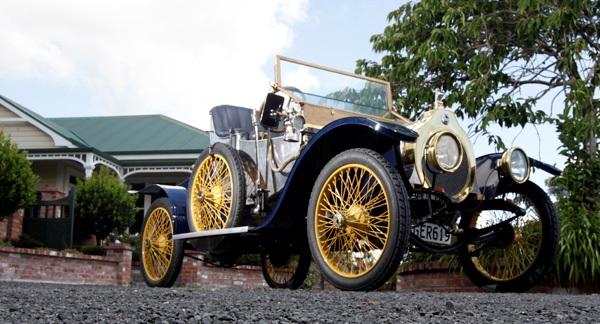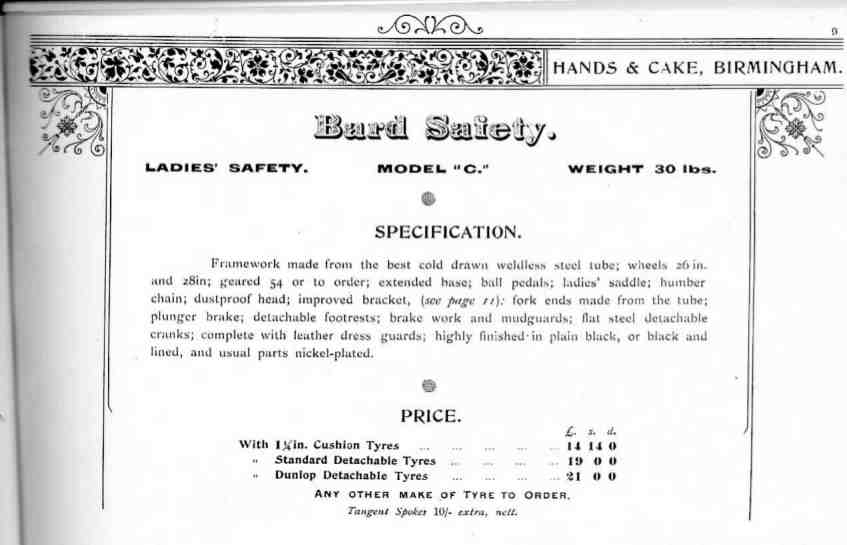The Calthorpe company was very much the creation of one man, George Hands. George William Hands was born in America to a British family which was temporarily relocated to Bridgport, Connecticut presumably due to his father, John Hands' occupation as an engine fitter. Back in Birmingham George served an early apprenticeship as a machinist before, in his early twenties, setting up his first company, Bard Cycles, with an Arthur Cake in 1895. A catalogue was published showing a range of sturdy but conventional machines. Capital was raised through a share issue backed by the usual flowery share certificates supported by local dignitaries. The Bard company was not particularly successful, the 1899 accounts appearing to show that most of the working capital had been transformed into unsold machines, entered in the books at the Directors' valuation. Nevertheless a Bard motor tricycle was reported as being made at about the same time.
The Bard Cycle Company disappeared shortly afterwards and George Hands is next reported in 1905 making and marketing the Calthorpe car. By then he was also a cycle manufacturer on quite a large scale, selling machines under three brands, the Minstrel (a reference back to his old Bard company), the Rea (the name of a local river near his Works) and the Fiscal, a cheaper machine which could also be supplied unbadged so that retailers could apply their own transfers. The names Minstrel and Rea are significant in the Calthorpe Motorcycle Company; to the end the company title was 'Calthorpe Motorcycle Company, proprietors Minstrel and Rea Cycle Co'.
Incidentally the name Calthorpe seems to have been simply pinched from the Calthorpe Estate, large landowners in Birmingham who may even have been his landlord at his Barn Street Works.
Creation
The Minstrel and Rea cycle business was evidently well established by 1905; a visit by the magazine 'Bicycling News' in that year described a bustling factory producing 200 or more machines a week. The enamelling processes were particularly admired and all machines from the cheapest Rea upwards were seen to be extremely well finished.
The business was based at Lion Works, Barn Street, Digbeth, Birmingham which in the early days housed the car business also. The car activities were moved to the Cherrywood Road works in Bordesley Green, Birmingham by 1912 but the cycle and motorcycle business remained at Barn Street throughout the life of the original company.
A limited Company, The Minstrel and Rea Cycle Company was formed in 1906, the directors being George Hands, Mrs F A Hands, A Willow, T R Fletcher, Mrs M Fletcher, A L Stamps and Mrs Agnes Stamps. This company is highly significant in the Calthorpe story; to the end in 1938 the Company title was always given as The Calthorpe Motorcycle Co (Proprietors Minstrel and Rea Cycle Co).


Employee welfare was not neglected, in 1907 Bicycling News reported a Works outing to the 'George' in Bewdley where a large party, presided over by George Hands, enjoyed a 'capital repast' followed, uncomfortably perhaps, by sports and tea.
Motorcycle manufacture - early years
In 1909 the motorcycling press buzzed with an important announcement which turned out to be the arrival of the first Calthorpe motorcycle. This was a sturdy single speed belt drive machine powered by the White and Poppe 3 1/2 HP single cylinder engine. Always ready with that unconventional touch, George added a magneto cut out actuated when the front brake was applied and producing slightly more retardation than that produced by the stirrup brake alone! The White and Poppe engine was soon superceded by a 'Calthorpe' engine, in reality a Precision made by F E Baker and representing the start of several years association with this company. A JAP powered version of the same model was also available.
The motorcycle business prospered producing a good variety of machines after 1910. The racing scene was embarked on with, it must be said, no very spectacular results. But this was an energetic company and the maximum publicity was extracted from both likely and unlikely sporting achievements. The first ascent of the Snowdon mountain in Wales was claimed for a lightweight machine at Easter 1914. Mainly Precision engined machines were produced from 1910 to 1914, from a hulking 750cc twin to a handsome 500cc TT replica to the strange 170 cc lightweight. In this little engine the valves protuded horizontally from the rear of the cylinder and were actuated via rocking beams by a camshaft which doubled up as the integral gearbox input shaft.
In 1915 a successful range of Peco (Pearson and Coles) two stroke and JAP four stroke models appeared. Production was interrupted in 1917 by the European conflict but restarted in 1919 with a similar range which continued with little change until 1924. During the war the Calthorpe factories were turned over to hand grenade production. Millions of these were produced making, one suspects, a pile of money for the shareholders.
The later Twenties
In 1924, for the 1925 season, with little publicity the firm produced its first in house engine, a very effective 350 cc push rod OHV unit. So nervous were they of failure of this engine that it was not promoted as a Calthorpe at all, simply as a new 350. But in fact the engine was extremely successful, withstanding considerable tuning and forming the basis of racing and even speedway versions. A well known tuner once described this engine as 'a JAP put right'. Praise indeed!
The new 350 soon displaced a motley range of Villiers, JAP and Blackburne engined models and was joined for 1927 by the most intriguing Calthorpe of all, the 500cc OHC model, known in the works simply as 'the Camshaft'. Unfortunately this model seems to have been rushed out probably in response to the famous Velocette TT victory with an OHC model and was never fully developed, performance in contemporary road tests being not much better than the, by now well sorted, 350. Trouble was also rumoured with Velocette who claimed patent infringement. Not surprisingly very few were made, not more than 100 judging by the frame and engine numbers of the survivors and only two complete machines and a few spare engines are known to now exist.
In 1929 the best remembered Calthorpe appeared, the Ivory. This was, for one year only, powered by the familiar upright 350 engine, though with the magneto repositioned behind the cylinder. This miodel produced one of Calthorpe's best years of production with well over 2000 machines turned out. A major redesign was on the way however and for that we will fast forward to the nineteen thirties.
The thirties
In 1930 the 350 appeared in the fashionable sloper layout. The engine also gained a cast in oil reservoir added to the front of the crankcase. 500 cc and 250 cc versions appeared in 1932 and 1934 respectively, the 250 supplanting a 250 cc Villiers engined model made for a short time in 1932.
The ivory paint scheme had been regarded by UK riders with some suspicion although overseas riders seem to have had no problem with it. The paint job may have contributed to a decline in sales, exacerbated by the depression and by lack of development though enclosed valves came along in 1936. Symptomatic of the falling off of Calthorpe's fortunes was the reduction in bore of the 350 in 1937 to allow the same frame and bottom end to be used for both models.. Many riders of the 1930's testified to the comfort and good manners of the sloper Calthorpes, a view repeated by no less an authority than the late Titch Allen in 'Vintage Roadtests'.
The firm's affairs became critical in 1937 and much of the output was marketed by the London dealers Pride and Clarke as the 'Red' Calthorpe, the same range but with red tank, mudguards and headlamp.. As a final effort to acquire what would now be called a new image a green finish was catalogued for 1938 but to no avail. By now the lack of development had taken its toll. The old 350 bottom end had not taken kindly to the increase in capacity to 500 cc and heavily used and neglected machines became known for destroying the timing side main bearing. It was reported that better reliability could be obtained by replacing the timing side bearing with a self aligning ball race which tolerated better the whip in the crank assembly. With modern useage styles thankfully this problem seems to have gone away. The original firm was wound up at the end of 1938.
The condition of the Barn Street works was by then deplorable, one report stating that before the final dispersal sale part of the roof had fallen in. The jigs, spares and rights to the Calthorpe name were bought by Bruce Douglas of Bristol who planned a range of Matchless engined machines but the war intervened when only a few had been completed and the fledgling manufacturers were summarily turned out of their works on Bristol aerodrome. Late in the war the name was sold again to Harold Nock of DMW who planned a 125 cc Villiers engined model. At least one machine was completed and road tested by 'Motor Cycling' but when the model finally appeared it was as plain DMW. And that was absolutely the end of the Calthorpe marque. Its founder, George Hands, had retired from the car and motorcycle business in the twenties and turned his attention to hotel and property development not to mention racehorses and could be said to have taken his eye off the ball as far as the Calthorpe business was concerned. The works was run by an able manager, Ken Griffiths, for most of the twenties and thirties but even he could do nothing about the lack of investment and final decline.
This account is an updated version of one originally written for Kings Norton Motorcycle Club.
Dick Weekes




















